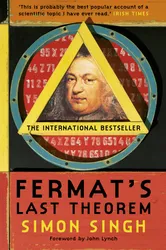When he died in 1665, the French mathematician Pierre de Fermat left behind an intriguing mathematical puzzle, scribbled in the margin of another maths book. He stated that the equation xn + yn = zn has no whole number solutions for n greater than 2. He also said:
I have discovered a truly marvellous proof of this, which this margin is too narrow to contain.
Proving this conjecture became the greatest unsolved problem in mathematics, and this book tells the story of that problem from its origins in the mathematics that preceded Pierre de Fermat, all the way through to the proof given by the British mathematician Andrew Wiles in the 1990s. (One of the things I learned from the book was the difference between a theory and a conjecture. Since he didn’t provide a proof, Fermat’s Last Theorem was actually a conjecture, until it was finally proved. But since Fermat claimed that he had proved it, the “theorem” part of the name stuck.)
Along the way, Singh discusses the nature of mathematical proofs, why they are important, and some of the ways that mathematicians have managed to prove their theorems. He includes examples of some different types of mathematical proofs, including proof by induction and proof by contradiction.
Many mathematicians over the years have attempted to prove the conjecture, or ended up providing important mathematical techniques that ended up being useful in the eventual proof. Singh tells the stories of some of these mathematicians, and explains the mathematics that they worked on, as well as giving us background information on their lives and personalities. There are some really fascinating, and tragic, characters who have been involved in the search for a proof.
As the book progresses, the mathematics being discussed becomes more complex, and the actual mathematics involved in Wiles’ proof is presumably much too complex for a popular book such as this. Singh includes analogous examples from other areas of mathematics to convey the ideas, and describes the theories well in words without getting into too much detail.
The book also tells the story of Wiles’ quest to solve the problem, from being introduced to it at an early age, and his lifelong attempts to solve the problem. The book describes a dramatic lecture given by Andrew Wiles in June 1993, when he announced that he’d proved Fermat’s Last Theorem. This made headlines at the time. But it turned out that Wiles’ had made a mistake in the proof he announced, and it took more than a year for him to correct his mistake.
Although Fermat suggested that he had a simple proof, so far no such simple proof has been found using the mathematical techniques that were available to Fermat at the time. Instead, Wiles’ proof involved much more complex mathematics that had been developed over the centuries since Fermat.
There is something a little unsatisfying about the proof that was eventually produced. Fermat’s conjecture is relatively simple to understand for anyone who has studied mathematics in school. But understanding the proof is beyond everyone except the most highly trained mathematicians. Those of use who aren’t so well versed in mathematics will just have to take the mathematicians’ word for it. It still leaves open some hope that there is a simpler proof.
At the end of the book, Singh discusses some outstanding problems that may take over the role of the greatest unsolved problem in mathematics. As the book was published in 1997, I had a quick look on Wikipedia to see if any of them had been solved since then. One of the problems is called the Kepler Conjecture and this seems to have been formally proved in 2017. However, at the time of writing, there are still unsolved problems related to Perfect Numbers.
I really enjoyed this book. It makes this mathematical story exciting to read about, and introduces lots of mathematical ideas in an understandable way.
